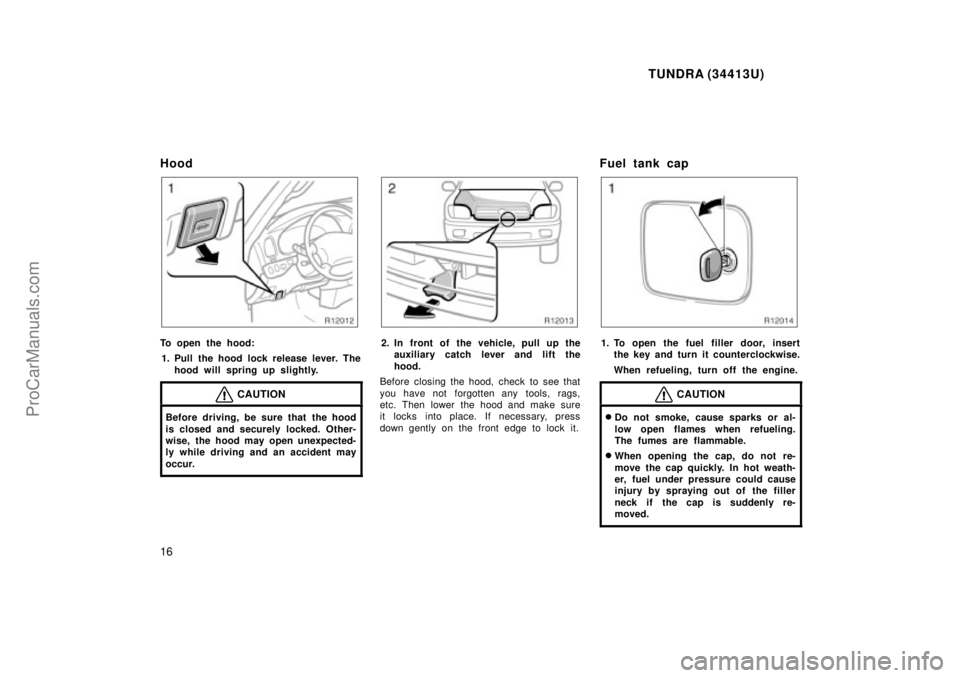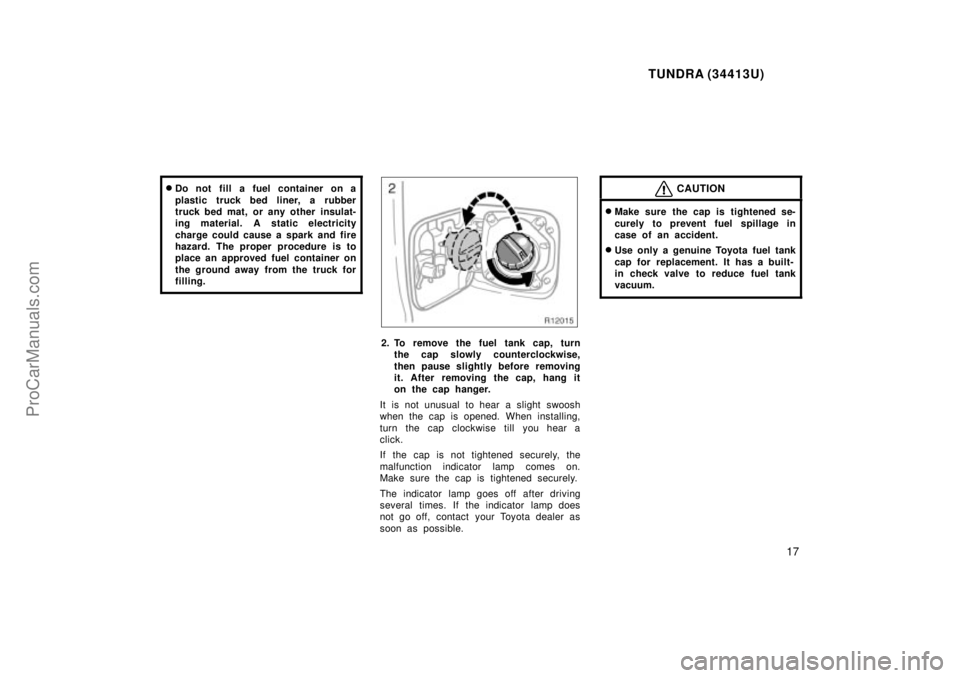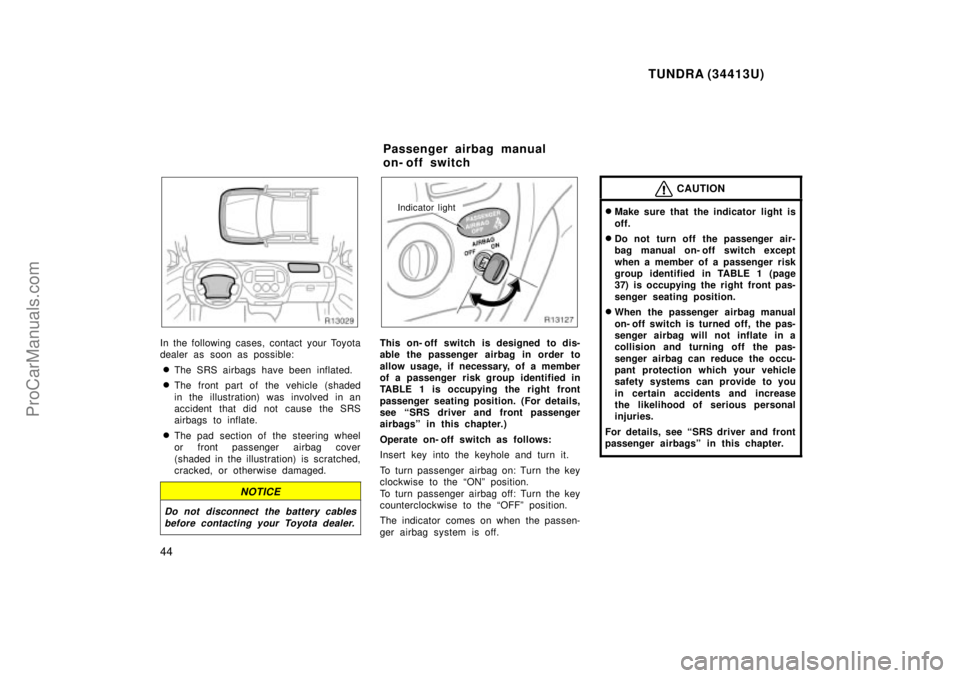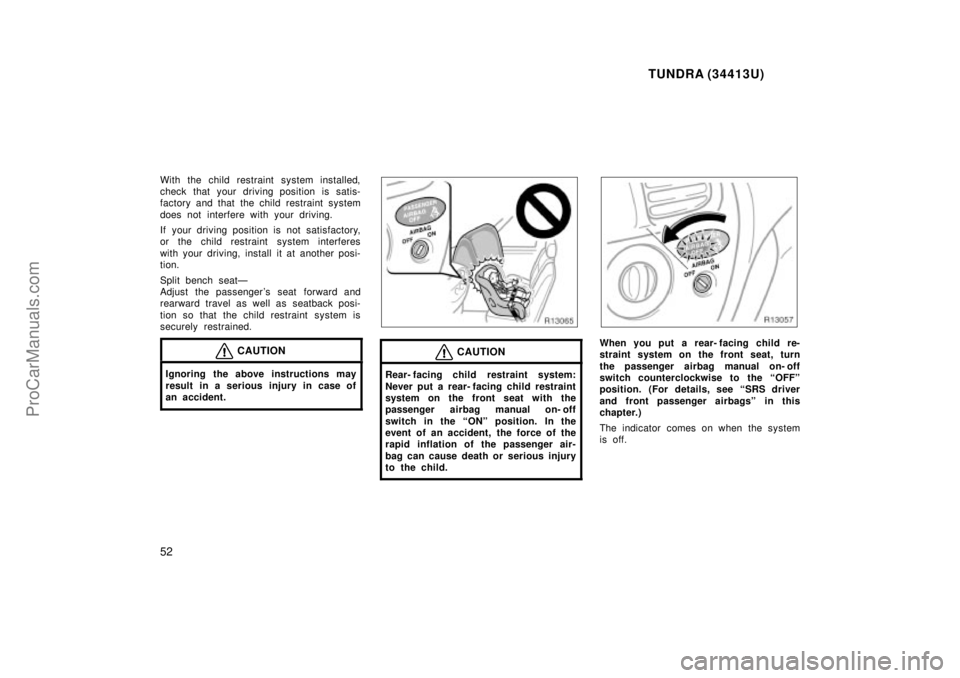Page 3 of 283
TUNDRA (34413U)
3
1. Front fog light switch
2. Headlight and turn signal switch
3. Wiper and washer switches
4. Automatic transmission selector lever
5. Cargo lamp switch
6. Emergency flasher switch
7. Car audio
8. Air conditioning controls
9. Passenger airbag manual on- off switch
10. Clock
11. Cup holder
12. Power outlets
13. 4LOº button
14. 2WD/4HIº button
15. Ashtray
16. Cigarette lighter
17. Cruise control switch
18. Ignition switch
19. Tilt steering lock release lever
20. Instrument panel light control knob
21. Clutch start cancel switch
ProCarManuals.com
Page 15 of 283
TUNDRA (34413U)
15
2. Tilt the tailgate to about 305 from
vertical and pull up the right side of
the tailgate to unhook the right side.3. Slide the tailgate a little to the right to unhook the left side.
To attach the tailgate, follow the removal
procedure in reverse order.
After closing the tailgate, try pulling it to-
ward you to make sure it is securely
closed.
We recommend you keep the tailgate
closed when not in use.
NOTICE
Make sure the support brackets are securely latched on both side panelswhen installing the tailgate.
LOCKING AND UNLOCKING WITH KEY
Insert the key into the keyhole and turn
it to lock or unlock the tailgate.
To lock: Turn the key clockwise.
To unlock: Turn the key counterclockwise.
ProCarManuals.com
Page 16 of 283

TUNDRA (34413U)
16
Hood
To open the hood:1. Pull the hood lock release lever. The hood will spring up slightly.
CAUTION
Before driving, be sure that the hood
is closed and securely locked. Other-
wise, the hood may open unexpected-
ly while driving and an accident may
occur.
2. In front of the vehicle, pull up theauxiliary catch l ever and lift the
hood.
Before closing the hood, check to see that
you have not forgotten any tools, rags,
etc. Then lower the hood and make sure
it locks into place. If necessary, press
down gently on the front edge to lock it.
Fuel tank cap
1. To open the fuel filler door, insert the key and turn it counterclockwise.
When refueling, turn off the engine.
CAUTION
�Do not smoke, cause sparks or al-
low open flames when refueling.
The fumes are flammable.
�When opening the cap, do not re-
move the cap quickly. In hot weath-
er, fuel under pressure could cause
injury by spraying out of the filler
neck if the cap is suddenly re-
moved.
ProCarManuals.com
Page 17 of 283

TUNDRA (34413U)
17
�
Do not fill a fuel container on a
plastic truck bed liner, a rubber
truck bed mat, or any other insulat-
ing material. A static electricity
charge could cause a spark and fire
hazard. The proper procedure is to
place an approved fuel container on
the ground away from the truck for
filling.
2. To remove the fuel tank cap, turn
the cap slowly counterclockwise,
then pause slightly before removing
it. After removing the cap, hang it
on the cap hanger.
It is not unusual to hear a slight swoosh
when the cap is opened. When insta lling,
turn the cap clockwise till you hear a
click.
If the cap is not tightened securely, the
malfunction indicator lamp comes on.
Make sure the cap is tightened securely.
The indicator lamp goes off after driving
several times. If the indicator lamp does
not go off, contact your Toyota dealer as
soon as possible.
CAUTION
�Make sure the cap is tightened se-
curely to prevent fuel sp illage in
case of an accident.
�Use only a genuine Toyota fuel tank
cap for replacement. It has a built-
in check valve to reduce fuel tank
vacuum.
ProCarManuals.com
Page 36 of 283

TUNDRA (34413U)
36
CAUTION
A driver or front passenger too close
to the steering wheel or dashboard
during airbag deployment can be
killed or seriously injured. Toyota
strongly recommends that:
�The driver sit as far back as pos-
sible from the steering wheel while
still maintaining control of the ve-
hicle.
�The front passenger sit as far back
as possible from the dashboard.
�All vehicle occupants be properly
restrained using the available seat
belts.
Indicator light
The passenger airbag system is
equipped with a manual on- off switch
and indicator light. Turning the passen-
ger airbag manual on- off switch clock-
wise to the ONº position makes the
passenger airbag system operational.
Turning the passenger airbag manual
on- off switch counterclockwise to the
OFFº position disables the passenger
airbag system. The indicator light on
the passenger airbag manual on- off
switch will come on when the passen-
ger airbag system has been disabled.
See Passenger airbag manual on- off
switchº in this chapter for detail.
CAUTION
�Make sure that the indicator light is
off.
�Do not turn off the passenger air-
bag manual on- off switch except
when a member of a passenger risk
group identified in TABLE 1 is oc-
cupying the right front passenger
seating position.
�When the passenger airbag manual
on- off switch is turned off, the pas-
senger airbag will not inflate in a
collision and turning off the pas-
senger airbag can reduce the occu-
pant protection which your vehicle
safety systems can provide to you
in certain accidents and increase
the likelihood of serious personal
injuries.
ProCarManuals.com
Page 44 of 283

TUNDRA (34413U)
44
In the following cases, contact your Toyota
dealer as soon as possible:
�The SRS airbags have been inflated.
�The front part of the vehicle (shaded
in the illustration) was involved in an
accident that did not cause the SRS
airbags to inflate.
�The pad section of the steering wheel
or front passenger airbag cover
(shaded in the illustration) is scratched,
cracked, or otherwise damaged.
NOTICE
Do not disconnect the battery cablesbefore contacting your Toyota dealer.
Indicator light
This on- off switch is designed to dis-
able the passenger airbag in order to
allow usage, if necessary, of a member
of a passenger risk group identified in
TABLE 1 is occupying the right front
passenger seating position. (For details,
see SRS driver and front passenger
airbagsº in this chapter.)
Operate on- off switch as follows:
Insert key into the keyhole and turn it.
To turn passenger airbag on: Turn the key
clockwise to the ONº position.
To turn passenger airbag off: Turn the key
counterclockwise to the OFFº position.
The indicator comes on when the passen-
ger airbag system is off.
CAUTION
�Make sure that the indicator light is
off.
�Do not turn off the passenger air-
bag manual on- off switch except
when a member of a passenger risk
group identified in TABLE 1 (page
37) is occupying the right front pas-
senger seating position.
�When the passenger airbag manual
on- off switch is turned off, the pas-
senger airbag will not inflate in a
collision and turning off the pas-
senger airbag can reduce the occu-
pant protection which your vehicle
safety systems can provide to you
in certain accidents and increase
the likelihood of serious personal
injuries.
For details, see SRS driver and front
passenger airbagsº in this chapter.
Passenger airbag manual
on- off switch
ProCarManuals.com
Page 49 of 283
TUNDRA (34413U)
49
When you put a rear- facing child re-
straint system on the front seat, turn
the passenger airbag manual on- off
switch counterclockwise to the OFFº
position. (For details, see SRS driver
and front passenger airbagsº in this
chapter.)
The indicator comes on when the system
is off.
CAUTION
If you must put a rear- facing child
restraint system on the front seat,
make sure the passenger airbag
manual on- off switch is in the OFFº
position and that the indicator light is
on.
CAUTION
�Do not put a rear- facing child re-
straint system on the rear seat if
the child restraint system interferes
with the front seat lock mechanism
or with your proper driving posi-
tion. This can cause severe injury
to the child and front passenger in
case of sudden braking or a colli-
sion.
�If your driving position is not satis-
factory, install the child restraint
system at another position.
ProCarManuals.com
Page 52 of 283

TUNDRA (34413U)
52
With the child restraint system installed,
check that your driving position is satis-
factory and that the child restraint system
does not interfere with your driving.
If your driving position is not satisfactory,
or the child restraint system interferes
with your driving, install it at another posi-
tion.
Split bench seatÐ
Adjust the passenger 's seat forward and
rearward travel as well as seatback posi-
tion so that the child restraint system is
securely restrained.
CAUTION
Ignoring the above instructions may
result in a serious injury in case of
an accident.
CAUTION
Rear- facing child restraint system:
Never put a rear- facing child restraint
system on the front seat with the
passenger airbag manual on- off
switch in the ONº position. In the
event of an accident, the force of the
rapid inflation of the passenger air-
bag can cause death or serious injury
to the child.
When you put a rear- facing child re-
straint system on the front seat, turn
the passenger airbag manual on- off
switch counterclockwise to the OFFº
position. (For details, see SRS driver
and front passenger airbagsº in this
chapter.)
The indicator comes on when the system
is off.
ProCarManuals.com